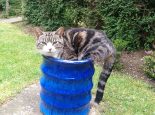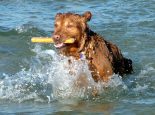A life-long learning curve

All vets in practice have to undertake yearly training to stay on the Royal College of Veterinary Surgeon register. This allows them to explore in more detail the specialist areas that interest them, expanding their knowledge and broadening the service offered by the practice. Vet Laura Frost gives insight into her recent experience with referral clinicians
My week with the specialists I recently spent a week shadowing an amazing team of surgical specialists at a big referral hospital. As at our practice, they perform rounds every morning, similar to a human hospital. Each inpatient is assessed by an intern who updates the whole team and discusses the plan for the day. Charts are filled in for pain relief, feeding regime and wound care. One inpatient that sticks in my mind was a lovely Labrador who for the third time had swallowed something he shouldn’t (this time it was a ball).
After surgery last night his body had made something called ‘adhesions’ which are fibrous bands between his organs making the surgery difficult and potentially more painful than it would have been for a ‘first time offence.’ But luckily he had a vet on hand who specialises in pain who assessed him throughout the night, mixing up the perfect cocktail of meds to get him through the first crucial 24 hours. Obviously I quizzed this man at every opportunity, making the most of his knowledge and ordering new medicines in for my practice.
‘Seeing cutting-edge techniques, some in the process of being developed by the specialists themselves, was hugely exciting’
The rest of the day was made up of admission appointments ready for Tuesday, which is a surgery only day. First was a puppy with a large hernia. He went to ultrasound to rule out any other congenital issues. After getting the all clear the owners, much relieved, he went back to their owner practice for the hernia repair later in the week. He was so relaxed for his scan, snoozing on the table and enjoying his chin being tickled. If only patients were as… patient. Next was a poor Westie with nasty ear disease, something that is seen a lot in general practice. Unfortunately his ears had got past the point of antibiotics and drops, the ear canals becoming very thickened with not much air flow.
Having done a small amount of ear surgery, I was very interested to see what their approach would be. When he went to theatre the next day I took note of small differences in equipment and technique that made the surgery quicker and easier to visualise than it had previously been. Seeing cutting-edge techniques, some in the process of being developed by the specialists themselves, was hugely exciting and I look forward to adapting some of the things I learnt to future cases of my own.
‘I’ve learnt some new tips to help make some of the surgery I already do less invasive and less painful for my patients’
The highlight of the week was seeing a dog with a pneumothorax successfully treated and wagging his tail the morning after surgery. He was so poorly when he first arrived and needed chest drains to take the air away so that his breathing could improve. The difference in his attitude after this drainage was remarkable. He was so much more peaceful and almost had a look of relief on his face. He went for an MRI which showed amazing detail of his chest. As he was an old boy we all feared the worst, but no cancer was found, just a rather strange abnormality called a bulla. This is almost like a blister on the lung that was leaking air (something very rare that I had read about in text books but never seen). No-one really knows why they form, but they are thankfully benign and carry a good prognosis once removed. Unfortunately for the dog in question this required a big surgery to remove the affected section of lung.
I expected to be in surgery all day, but the slick technique of the surgical team allowed him to be opened up quickly and the lung lobe removed with a surgical stapler while the dog was on a ventilator. He was back in his kennel in less than two hours. By the next day he was bright and the issue was keeping him still rather than worrying about his pain or breathing. So in summary I learnt some new tips to help make some of the surgery I already do less invasive and less painful for my patients, saw some really cool surgery that is best to be left to the pioneers and had a huge list of things to order for my own practice. Do you think my boss will buy an MRI? Maybe not. But at least I know where to turn for any cases that need that extra level of expertise.
Laura Frost MRCVS MA VetMB is a vet at local veterinary practice Pengelly and Mizen
Pengelly and Mizen Veterinary Surgeons 89-93 Park Road, Peterborough PE1 2TR T: 01733 554953 Emergencies only: 01733 896000
www.pengellyandmizen.co.uk















